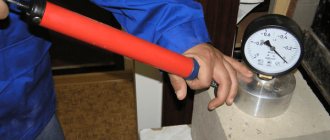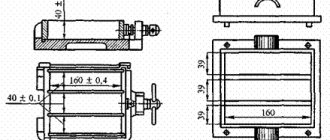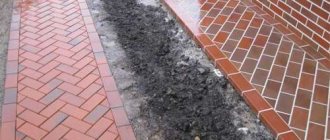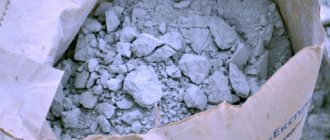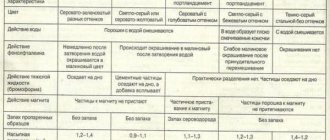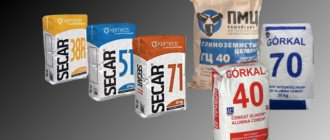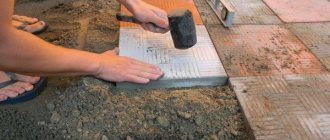Pozzolanic cements
For the construction of residential, industrial, and agricultural facilities operating in conditions of high humidity, various types of pozzolanic cements are used, consisting of an artificial binder - clinker with the addition of natural additives. Let's look at the main advantages, disadvantages and ways to use this mixture.
Composition, types and areas of application
What is pozzolana cement? The answer is simple - it is a hydraulic binder produced by grinding clinker (up to 80%) with high activity additives (up to 40%), plus a small amount of alabaster (no more than 3.5%).
The total annual production of such cement in Russia has reached 5 million tons.
Natural additives of volcanic (ash, pumice) and sedimentary origin (tripoli, opoka), as well as lime, baked clay, blast furnace slag in the composition of cement explain what pozzolana is.
The amount of these substances in a given compound is proportional to their properties and composition. The higher the activity of the additive, the lower the percentage of its content in the product.
Depending on the content of ingredients, the following types of products are produced:
- pozzolanic;
- calcareous-clay;
- lime-ash.
Pozzolanic cement is the most widespread of all the listed materials used in the construction of hydraulic structures (locks, canals, ports), underground communications (subways, tunnels), construction of basements, foundations and other similar places where there is interaction with fresh and sulfate waters .
This building material should not be used due to its low air resistance when installing above-ground concrete structures in natural conditions, which can lead to the cessation of its hardening and cause subsidence of part of the structure.
Pozzolanic cement has poor resistance to the alternating effects of thawing and freezing, drying and wetting, which limits its scope of application.
It is not recommended to prepare a concrete mixture from this cement at temperatures of 0° C and below due to low frost resistance.
Technical indicators
According to GOST 31108–2003, pozzolanic Portland cement has the following characteristics shown in the table:
No. Name of properties Quantity Note
| 1 | Active additives (%) | 20–40 | |
| 2 | Density (g/cm³) | 2,7–2,9 | |
| 3 | Shelf life (month) | 6 | In a dry place |
| 4 | Compressive Strength(MPa) | 42,5–62,5 | After 28 days |
| 5 | Setting time start/end (hour:min) | 0:45/12:00 | |
| 6 | Flexural strength (MPa) | 6,8 | After 28 days |
| 7 | Density of cement paste (%) | 28–35 | |
| 8 | Volumetric weight (kg/m³) | 800–1000 | In a loose state |
| 9 | Specific gravity (kgf/m³) | 2,7–2,9 | |
| 10 | Volumetric weight (kg/m³) | 1200–1600 | In compacted form |
| 11 | Grinding fineness on sieve No. 008 (%) | To 10 |
Advantages and disadvantages
Pozzolanic cements have a number of advantages over conventional building mixtures:
- high level of connection with metal reinforcement in reinforced concrete structures;
- absence of a large number of cracks in finished products;
- durability of structures built with their use;
- release of more mortar and concrete;
- ease of processing and obtaining a smoother surface of products;
- resistance to fresh and mineralized water when compacted;
- quick setting;
- exceeds the strength of conventional concrete in autoclave manufacturing of structures;
- The cost of mass production is much lower.
The disadvantages of this cement are:
- low air resistance;
- large needs for water during the preparation of solutions;
- shorter shelf life, and as a result – a decrease in strength characteristics;
- poor resistance to low temperatures and humidity changes.
Let's summarize. Pozzolanic cements, despite minor disadvantages, have significant advantages that make them indispensable in the construction of hydraulic, underground, and other structures that require high strength and resistance to high humidity.
Source: https://www.hugebuilding.ru/puccolanovyj-cement.html
Where is it used?
Pozzolanic cement mortar has an extremely limited range of uses. The areas of application of this building material are determined by its special properties. It has a lighter shade compared to other types of cement.
When setting and further hardening, the cement mortar, which includes a synthetic binder component, does not generate a large amount of heat - this effect is especially important when constructing volumetric structures in the summer. In addition, this concrete is characterized by increased resistance to sulfate compounds and moisture.
The material can be used for the construction of underwater and underground parts of hydraulic structures, which during operation will come into contact with fresh or sea water.
Such structures include:
- protective jetties;
- gateways;
- dams;
- embankments;
- docks, etc.
In addition, this material can be used for the construction of underground water supply and sewerage structures. It is often used in the construction of mine shafts, tunnels, underground bunkers and tanks.
It can be used to form structures intended for irrigation and drainage purposes. This type of material is also recommended for the construction of residential buildings and industrial buildings that will be exposed to groundwater containing aggressive impurities.
Experts advise using this type of concrete for the construction of only basement floors, basements, and foundations that will be in contact with moisture, protected from temperature changes.
In addition, this cement is suitable for the production of reinforced concrete products using steaming technology, which provides them with greater strength and the ability to use them in aggressive conditions.
Comparative characteristics of pozzolanic Portland cement and simple cement
The additive is first dried. it makes up 20-50% of the weight of the mixture.
To produce this cement, high quality clinker should be used. When grinding, to regulate the setting of cement, gypsum dihydrate is added to it, as usual. The production of this cement uses less fuel and its cost is lower than that of ordinary cement.
Properties of cement.
Pozzolanic Portland cement is lighter in color than ordinary cement. Its specific gravity (about 2.8-2.9) and volumetric weight are less than that of ordinary cement.
With the same weight dosage, pozzolanic Portland cement gives a higher yield and density of dough, mortar and concrete than ordinary cement, as a result of which mortars and concrete are more waterproof.
To obtain a dough of normal thickness, more water must be added to pozzolanic Portland cement (up to 30-40%), and it forms a more viscous mixture than ordinary cement.
Due to this, the mobility of concrete mixtures decreases; to avoid this phenomenon, it is necessary to slightly (by 5-10%) increase the consumption of cement in concrete or introduce a plasticizing additive.
The grinding fineness, setting time and uniformity of volume change for the described cement should be the same as for ordinary cement; In practice, setting occurs more slowly.
Depending on the strength, pozzolanic Portland cements are
five grades: 200, 250, 300, 400 and 500. Our factories produce this cement for the construction of the largest hydraulic structures.
For this cement, according to GOST, the compressive and tensile strength of samples made from a standard mortar of rigid consistency with normal sand in a ratio of 1:3 (by weight) should not be lower than the values given in Table 1.
How to decipher cement markings
Cement is a binding powder used for the manufacture of building materials, buildings and other structures. It is made from clinker, limestone, various minerals and gypsum.
The area of use, characteristics and properties of cement depend on the composition and proportions of the components. The most common is Portland cement.
To produce it, limestone is added to clay.
Characteristics of cement powder
The cement structure, which has already hardened, is constantly exposed to the environment. So, if it is located on the street, then precipitation and salts fall on it. It freezes and thaws.
To improve corrosion resistance, polymer additives are added to the cement powder at the production stage. They reduce the degree of microporosity, making the material more reliable.
Not only the price of the binder component, but also its quality depends on such a parameter as the fineness of grinding. The smaller the fraction, the better the source material.
The hardening process of fine Portland cement occurs much faster than powder with large particles.
To ensure that cement has optimal characteristics, different fractions are mixed.
One of the main parameters that you should pay attention to when choosing Portland cement is the degree of frost resistance. The more freezing and thawing cycles it can withstand, the longer the structure built from it will last, and the less repairs it will require.
The scope of application of cement completely depends on this characteristic. Every time concrete freezes, the water it contains expands and breaks it down from the inside.
To improve the degree of frost resistance, mineral additives are added to the cement powder, for example, sodium abietate or neutralized wood pitch.
Cement also differs in strength. To determine the grade, a solution is prepared from one part of cement powder and three parts of quartz sand. Everything is thoroughly mixed to a homogeneous consistency and poured into the mold.
After 28 days, the test sample is placed under a press and pressed. The pressure at which it began to collapse is its mark. To determine it, 6 probes are tested. The arithmetic average is calculated from the 4 best.
The result obtained is considered its brand in terms of strength. This indicator is measured in MPa and kg/cm2.
Another characteristic on which the area of application of cement powder depends is the setting time. This parameter is especially important in conditions where emergency repairs are required or in cold climates.
The rate of hardening of Portland cement can be controlled using gypsum or other additives. Ambient temperature and water also influence. The colder the air, the longer the cement hardens.
Under optimal conditions and proper mixing, the cement mortar sets in 45 minutes.
Manufacturing process
To produce a pozzolanic cement mixture, a cement plant with a full technological cycle is required, i.e., a plant where Portland cement clinker is produced. Such industrial facilities differ from facilities dedicated exclusively to the production of Portland cement because they have a grinding department in which additives can be crushed and dried.
Factories most often use local raw materials as additives, so the name “pozzolanic” is quite arbitrary. Most often, natural mineral elements act as additives - diatomite, tripoli, glige, and less often - by-products from energy production.
After drying and crushing, the additives are fed into a special hopper located in front of the mill. Through a dispenser they enter the mill, where they are combined and ground together with gypsum and clinker. Separate grinding of clinker and additives is not beneficial, since it is difficult to achieve good mixing and obtain a homogeneous mass.
Types of Portland cement, their features and scope of application
Portland cement is a type of cement. It has a fairly large number of subspecies, which differ in scope, pricing policy and their properties.
The main feature of cement is the speed of its hardening in the first three days. This result is achieved by introducing slag granules or active minerals. In this case, it is recommended to crush the clinker more thoroughly. The produced grades M400 and M500 are intended for stressed structures and structures.
Due to the fast setting of cement, the holding time of the monolith in removable formwork is reduced. It is important to remember that fast-hardening cement cannot be stored for long periods of time. In just a few months it may completely lose its main advantages.
